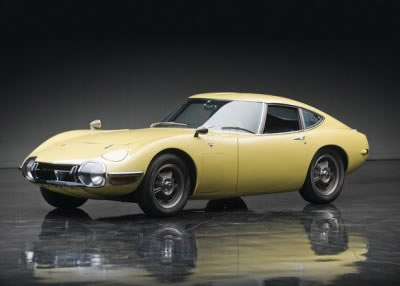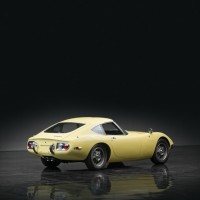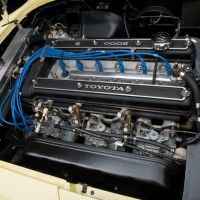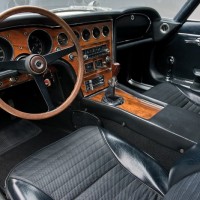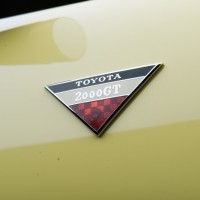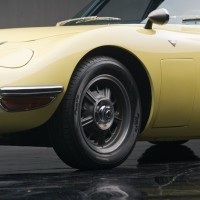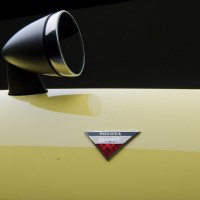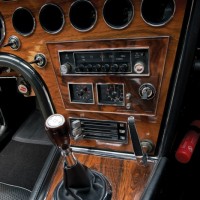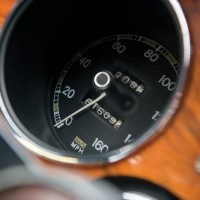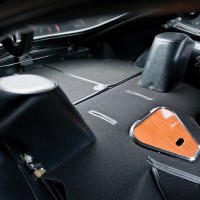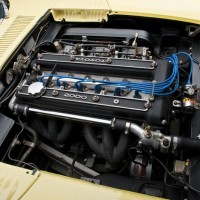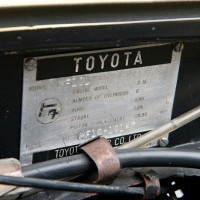SCM Analysis
Detailing
| Vehicle: | 1967 Toyota 2000GT |
| Number Produced: | 354 (84 LHD) |
| Original List Price: | $6,800 |
| Tune Up Cost: | $450 |
| Chassis Number Location: | Engine bulkhead |
| Engine Number Location: | Bottom left side of block |
| Club Info: | 2000GT Club, P.O. Box 628, Biddeford, ME 04005 |
This car, Lot 149, sold for $1,155,000, including buyer’s premium, at RM Auctions’ Don Davis Collection sale in Fort Worth, TX, on April 27, 2013.
You can now officially set your clock to it. Every six years, SCM publishes a profile of a Toyota 2000GT, first in 2001, then in February of 2007 and now in this issue. This proves to be a handy way of charting the progression in the market for these interesting cars — and also adding some context to the setting of a world record for a Japanese car at auction.
The late, great, Pat Braden — Alfista nonpareil — was also quite keen and knowledgeable about oddball sports cars. On p. 29 of the February 2001 issue of Sports Car Market, Braden wrote: “The Toyota 2000GT is one of the great “what-ifs” in recent automotive history. What if Toyota had developed the car, and produced a lower-cost successor? What if they had stayed with their racing program? What if they had made the interior big enough so that anyone over 5’9” didn’t have to fold up like a pretzel to fit?” Braden brought up some very interesting points that relate directly to the collector interest in this car.
Toyota’s sports car detour
The 2000GT sits in Toyota’s history much as the 507 in that of BMW. Both cars are fascinating cul-de-sacs with little relationship to what the brand meant at the time.
BMW found its way back decades later with the Z8, Toyota finally with the Lexus LFA. The 2000GT was not developed, but this didn’t hurt interest and concomitant values. The alleged headroom challenges of the Toyota have not held down appeal because 6-foot-tall drivers can actually pilot the 2000GT with superb comfort — despite the legend to the contrary.
Some have dismissed the 2000GT over the years because of its “hired-in” history. Yamaha originally started the project for Nissan. After Nissan abandoned the project, Toyota stepped in to join Yamaha. Toyota actually designed the car — not Albrecht Goertz, who was believed to be the designer for a long time.
The twin-cam head of the engine that Yamaha developed is very exciting and well-crafted, showing influences from Alfa Romeo engine architecture and informed by Grand Prix motorcycle practice.
The styling is beautiful, simple, organic and very much the sleek GT. Every surface is a compound curve, and, at the same time, the body incorporates “surface interest” in the details. This is uniquely Japanese, yet the details never seem overdone. Yamaha built all the cars, as they were better suited for the small production run than any Toyota factory.
From orphan to million-dollar baby
So, how did we get to a million-dollar Toyota?
It is frequently useful to look back over as long a period as possible at prices to see if there is a linear progression upward (or downward) — or if there are dramatic incidents which appear in an anomalous fashion, moving values sharply. The SCM Platinum Database contains 11 records of auction offerings of nine examples of the 2000GT, going back to May 1992. The entries show an interesting progression in prices, from two no-sales at $60k and $42.5k in 1992, a sale of Chassis 219 in August 1998 for $77.5k and Chassis 273 in March 1999 for $69.3k. Chassis 219 was described at the time as being “tired,” while 273 was said to have been “very original.”
Chassis 140 took a major step forward at $151k in October 2000, and it is the first of the cars to have been rated Condition 1. The next sale, in August 2001, was at $140k for another Condition 1 car.
Chassis 140 reappears at auction in July 2006, now rated in Condition 2, and it sells for $225.6k. The SCM reporter on site claimed the buyer “stole” the car at that amount.
Four years later, in 2010, we see a “re-creation” of the never-built Targa model, which sells at $283.6k.
Now we see another major step. Chassis 219, rated at Condition 2, crossed Gooding’s block in August 2012 for $627k.
So, does all this mean that this sale, at a record $1.15m, is the next increment? Well, probably not, but it is a clear indication that anecdotal reports of private sales in the $800k range seem credible.
Collected to drive
This car was a very nicely presented example — and in a rare color, Bellatrix Yellow. There were six factory colors offered, the most commonly encountered being Pegasus White, then red. Fit and finishes on our subject car were reported to be done to a high level.
There were several departures from stock — under the hood in particular. The bright blue spark-plug wires and contemporary aluminum radiator stand out, which, not unhappily, marked this car as one restored to drive.
There were apparently several other small trim finish details that varied from original build, but nothing that couldn’t be easily rectified.
No longer an obscure novelty
Braden’s profile ended with the following statement: “The 2000GT will always be an orphan car, with a limited following. If all the cars owned by the two dealers were to come on the market at the same time, we would likely see a price implosion. However, so long as the supply is strictly limited, prices for good cars should stay in the $100,000–$150,000 range.” With the advent of the new Toyota sports cars, the GT is less of an orphan. Tales of the limited market for this car are exaggerated. Why? Whenever they come to market, the bidding seems to be pretty spirited. And last, you’ll never see me prognosticating about long-term prices.
Don Rose, RM Auctions Specialist, and over 5’9” in height, is a 2000GT owner. Known as a true Aston Martin man, he’s had his Toyota for several years now. He also owns a Mazda Cosmo, so the idea that “Japanese” and “collectible” are not oxymorons is firmly planted in his head.
Rose revels in the refinement of the “sweet twin-cam engine, with its very linear torque range that also loves running in the high revs.” When asked what the most striking thing about his ownership experience has been, he replied that it has been the change in the reaction to the car.
It went from “You bought a what??” to “How cool is that!?” That neatly encapsulates and further reinforces the 2000GT’s sales history story from 1992 to today. This car was undoubtedly well sold, but not as well as you might have thought. ?
(Introductory description courtesy of RM Auctions.)
